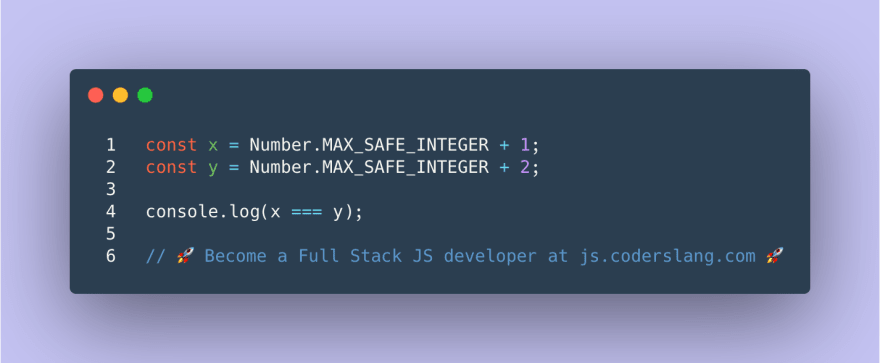An Interest In:
Web News this Week
- April 1, 2024
- March 31, 2024
- March 30, 2024
- March 29, 2024
- March 28, 2024
- March 27, 2024
- March 26, 2024
JavaScript Interview Question 41: Going above MAX_SAFE_INTEGER
True or false? What appears in the console?
.
.
.
.
.
.
.
.
.
.
.
.
.
.
.
.
.
JavaScript uses the double-precision floating-point numbers even to represent integers. This means that the biggest number that can be stored safely as a JS number is 2^53^ - 1 or 9007199254740991. This value is stored as a static constant Math.MAX_SAFE_INTEGER.
console.log(Math.MAX_SAFE_INTEGER); // 9007199254740991console.log(Math.pow(2, 53) - 1); // 9007199254740991Having the value Math.MAX_SAFE_INTEGER doesnt mean that its impossible to have a bigger number in JS. But, when we continue to increase the number, the loss of precision occurs.
console.log(Number.MAX_SAFE_INTEGER + 1); // 9007199254740992console.log(Number.MAX_SAFE_INTEGER + 2); // 9007199254740992As you see, by adding 1 and then 2 to Number.MAX_SAFE_INTEGER, we got the same number.
If youre building an application where such behavior is critical, then you should use BigInt instead of the regular JavaScript Number.
ANSWER: There will be a loss of precision due to rounding and safe integer overflow. Both x and y will equal 9007199254740992. The message true will be printed to the console.
Get my free e-book to prepare for the technical interview or start to Learn Full-Stack JavaScript
Original Link: https://dev.to/coderslang/javascript-interview-question-41-going-above-maxsafeinteger-3agl
Dev To
 An online community for sharing and discovering great ideas, having debates, and making friends
An online community for sharing and discovering great ideas, having debates, and making friendsMore About this Source Visit Dev To


